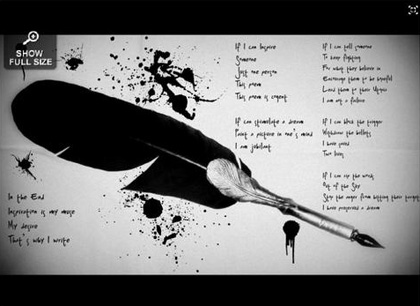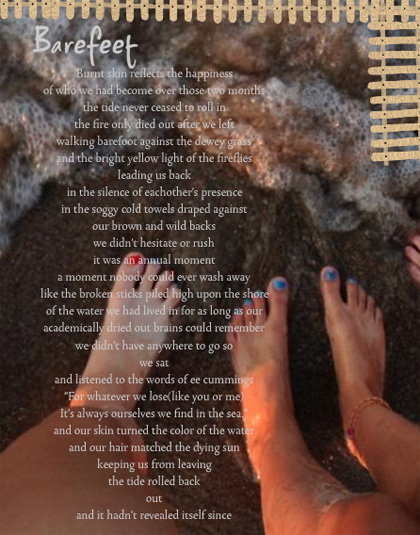 by Alexandra Panos
by Alexandra Panos
In this blog post, I hope to add to the growing number of voices advocating the importance of multimodal, digital poetry in the ELA classroom. As a middle school teacher in Chicago, a pulsing center of competitive high school choice, I have had to advocate strongly for an immersive poetry experience in my classroom. My school first transitioned to standards based reporting two years ago, and is now in the midst of a transition to the Common Core State Standards (CCSS). But, because of the ongoing scholarly arguments for poetry instruction and the quality work students produce, my administration has joined me in my endeavor to fully embrace poetry in my classroom.
Ryan’s Poetic Glogster

Students and teachers who engage in poetic exploration often immerse themselves in the reading and writing of poetry and poetic language. In a time of standards-based grading practices and curriculum design, the need for this exploration has grown, rather than diminished. Other scholars have made this argument better than I could, and I encourage classroom teachers to read, read, read the academic and classroom-tested literature available.
In Mark Dressman’s recent book, Let’s Poem, he directly addresses the world of multimodal poetic response and creation. Any teacher tackling poetry as either a new area or making the case for its inclusion in their CCSS classroom would benefit from his detailed, classroom tested, and exciting approaches to poetry, some of which I describe below.
Bridget Dalton’s recent piece, “Multimodal Composition and the Common Core State Standards” in The Reading Teacher lays out a framework for the integration of technology into the writing classroom. She argues that the open-endedness of the CCSS gives educators space to promote thoughtful multimodal, composition in the ELA classroom.
Most recently, Julie B. Wise wrote an encouraging piece on this blog directly aligned to the grade 5 CCSS classroom. Her plan for intertwining reading and writing digital poetry is accessible and adaptable for any classroom. The use of PowerPoint as a publication strategy emphasizes student language choices.
Ultimately, the argument comes down to the inherent importance of careful language study in the standards-based or CCSS classroom. Any way you teach it, poetry instruction should reflect the complexity of choices available to poet and reader, from which students have the right, and need, to make meaning in ever expanding and increasingly digital modes.
Audrey’s Poetic Glogster

Why Multimodal, Digital Poetry?
An added benefit of the shifting nature of literacy education is the emphasis on digital and multimodal literacies in the ELA classroom. Poetry reading and writing often require complex literacy events to unfold for students to make meaning. Luckily, with the expanding nature of the digital world, we are now better able to give our students quality methods with which to respond and create.
As with all multimodal responses and compositions, they have clear ties to pedagogical principles most ELA teachers already employ in their classrooms. Ties to the dramatic and fine arts have always been multimodal ways to engage with poetry, but we also can weave into our classroom practice new digital methods that support and extend our facilitation of student learning. I hope this brief list of more “traditional” multimodal ideas can further encourage teachers to either take up multimodal poetry as an integral component of their classroom culture or extend to digital modes as well.
Lilly’s Poetic Glogster
Choral Poetry
Reading poetry aloud is one of the original multimodal methods of approaching poetry in the ELA classroom according to Mark Dressman. In my classroom we do choral readings of The Bells by Edgar Allan Poe, blues poems by Langston Hughes, and, if requested, my students’ writing. The shared nature of the readings help students learn from and with one another. Let’s Poem has a wonderful breakdown of how to engage in choral reading.
To extend to digital work, try using Garage Band to create poetry podcasts!
Spoken Word Poetry
Folding spoken word poetry into the classroom can mean a greater awareness of both the aural and figurative natures of language. In my 8th grade classroom, we watch portions of the fantastic documentary Louder than a Bomb which follows students as they compete in the largest spoken word poetry slam in the country of the same name. It is inspiring and motivating for student writers. As we workshop our own poems, we also make time for daily mini-slams. Sharing poetry orally inspires critique of language as well as reaches out to other modes of art, such as rap and music. Let’s Poem also has great resources for application in your own classroom.
To extend to digital work, have students create “music videos” to accompany their own spoken word poems!
Artistic Interpretations
Students have visceral responses to many of the images they find in poems we read and write in my classroom. I’ve found that artistic response is often a powerful way for them to demonstrate their emotions as well as create meaning. They do this for a range of poems, from Hurt Hawks by Robinson Jeffers to Naomi Shihab Nye’s Sifter to the lyrics of their favorite songs. In particular, their own writing lends itself well to artistic interpretation as it provides them a means of broadening the figurative language found in their poems.
To extend to digital work, have students create Glogsters of images, sounds, and video!
Franny’s Poetic Glogster

Publishing Multimodal, Digital Poetry in my Classroom
My students and I enjoy reading and writing poetry throughout the school year, but place special emphasis on it in the cold Chicago winters, when we dive into the depths of poetic language. This brief month of intense focus has led to carefully crafted poems which we publish digitally using Glogster.com.
While I am not writing here to share a unit plan, I hope solid examples of some student work and my grading tool might benefit others who hope to facilitate the publication of multimodal, digital poetry. To create these detailed poetic Glogsters, students must meet several criteria, and make careful choices about their work. The most important of these criteria include:
- Purposeful edits through independent work as well as peer and teacher conferences
- CCSS.ELA-Literacy.W.8.5 With some guidance and support from peers and adults, develop and strengthen writing as needed by planning, revising, editing, rewriting, or trying a new approach, focusing on how well purpose and audience have been addressed
- Intentional use of figurative and aural language, poetic form or line break, and sensory devices and images
- CCSS.ELA-Literacy.W.8.3d Use precise words and phrases, relevant descriptive details, and sensory language to capture the action and convey experiences and events
- Appropriate synthesis of information through writing, images, video, sound, and use of space
- CCSS.ELA-Literacy.W.8.6 Use technology, including the Internet, to produce and publish writing and present the relationships between information and ideas efficiently as well as to interact and collaborate with others.
Seventh and eighth graders wrote, designed and published the pieces shared here. I have my students for three years, as such this is either the second or third year these students have had an immersive month of multimodal and digital poetry. Some students, such as Lilly, add music, video and moving images, fully embracing the digital nature of Glogster as a medium. Others, such as Audrey, look at their Glogster as a still canvas. Rather than force students to use specific media, I ask that they write a reflective paragraph which explains the choices they made. This provides more formal writing practice as well as cements the meanings they are making.
My immersive month of poetry with my students is my favorite time of the year. Our final step is to embed our Glogsters into Edmodo.com, an education social networking site. Here students comment on one another’s work, discuss the language chosen, and feel the real sense of accomplishment which comes with publication. Students learn, standards are assessed, and we grow as a community of readers and writers because of the intricacy of choices we make in our study and creation of poetry.
Josie’s Poetic Glogster
Resources
Common Core State Standards Initiative. (2010). Common Core State Standards forEnglish Language Arts & Literacy in History/Social Studies, Science, and TechnicalSubjects. Washington, DC: National Governors Association Center for Best Practices and the Council of Chief State School Officers. Accessed from:http://www.corestandards.org/the-standards
Dalton, Bridget. "Multimodal Composition and the Common Core State Standards." The Reading Teacher 66.4 (2012): 333-39. Print.
Dressman, Mark. Let's Poem: The Essential Guide to Teaching Poetry in a High-stakes, Multimodal World. New York, NY: Teachers College/Teachers College, Columbia University, 2010. Print.
"Edmodo | Where Learning Happens | Sign Up, Sign In." Edmodo | Where Learning Happens | Sign Up, Sign In. Web. 25 Feb. 2013.
"We Are Celebrating!" Glogster. Web. 25 Feb. 2013.
Wise, Julie B. "TILE-SIG Feature: Digital Poetry Bridging Common Core Standards with Multimodal Instruction." TILE-SIG Feature: Digital Poetry Bridging Common Core Standards with Multimodal Instruction. International Reading Association, n.d. Web. 25 Feb. 2013.
Alexandra Panos is a middle grades Language Arts teacher in Chicago. Her future posts will focus on multimodal approaches which support digital literacy.
This article is part of a series from the International Reading Association Technology in Literacy Education Special Interest Group (TILE-SIG).